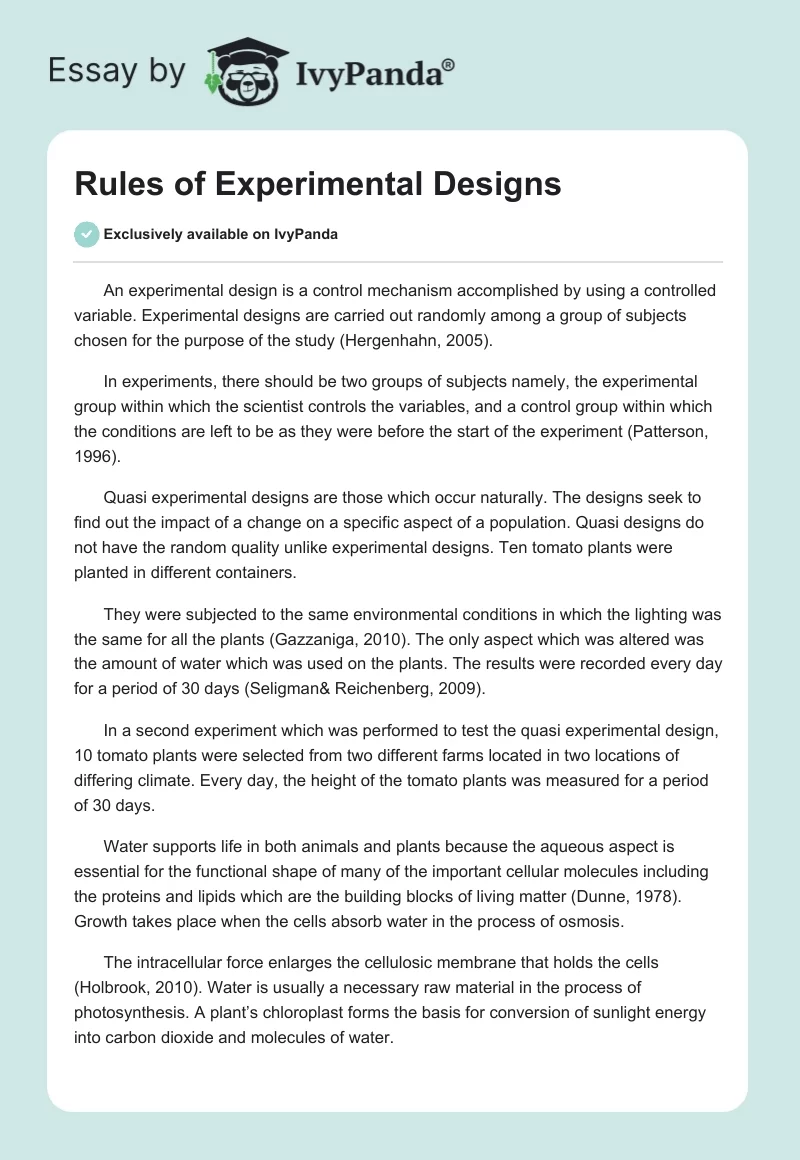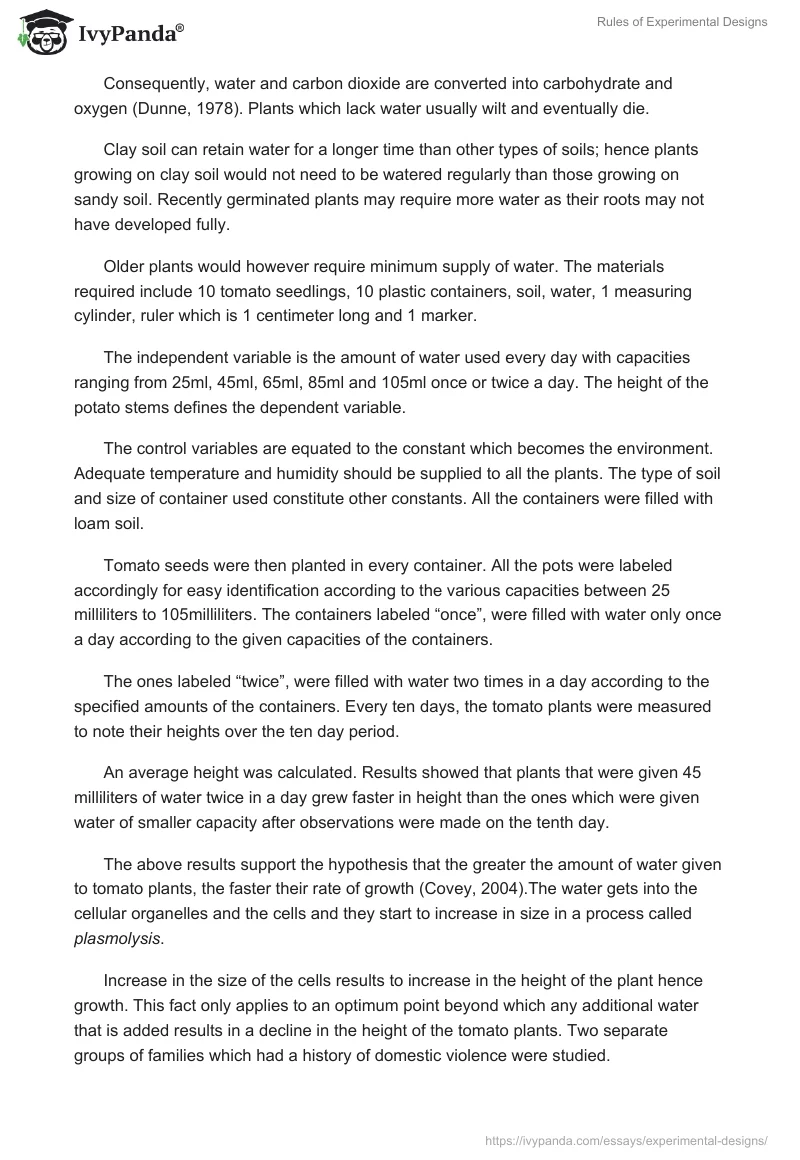An experimental design is a control mechanism accomplished by using a controlled variable. Experimental designs are carried out randomly among a group of subjects chosen for the purpose of the study (Hergenhahn, 2005).
In experiments, there should be two groups of subjects namely, the experimental group within which the scientist controls the variables, and a control group within which the conditions are left to be as they were before the start of the experiment (Patterson, 1996).
Quasi experimental designs are those which occur naturally. The designs seek to find out the impact of a change on a specific aspect of a population. Quasi designs do not have the random quality unlike experimental designs. Ten tomato plants were planted in different containers.
They were subjected to the same environmental conditions in which the lighting was the same for all the plants (Gazzaniga, 2010). The only aspect which was altered was the amount of water which was used on the plants. The results were recorded every day for a period of 30 days (Seligman& Reichenberg, 2009).
In a second experiment which was performed to test the quasi experimental design, 10 tomato plants were selected from two different farms located in two locations of differing climate. Every day, the height of the tomato plants was measured for a period of 30 days.
Water supports life in both animals and plants because the aqueous aspect is essential for the functional shape of many of the important cellular molecules including the proteins and lipids which are the building blocks of living matter (Dunne, 1978). Growth takes place when the cells absorb water in the process of osmosis.
The intracellular force enlarges the cellulosic membrane that holds the cells (Holbrook, 2010). Water is usually a necessary raw material in the process of photosynthesis. A plant’s chloroplast forms the basis for conversion of sunlight energy into carbon dioxide and molecules of water.
Consequently, water and carbon dioxide are converted into carbohydrate and oxygen (Dunne, 1978). Plants which lack water usually wilt and eventually die.
Clay soil can retain water for a longer time than other types of soils; hence plants growing on clay soil would not need to be watered regularly than those growing on sandy soil. Recently germinated plants may require more water as their roots may not have developed fully.
Older plants would however require minimum supply of water. The materials required include 10 tomato seedlings, 10 plastic containers, soil, water, 1 measuring cylinder, ruler which is 1 centimeter long and 1 marker.
The independent variable is the amount of water used every day with capacities ranging from 25ml, 45ml, 65ml, 85ml and 105ml once or twice a day. The height of the potato stems defines the dependent variable.
The control variables are equated to the constant which becomes the environment. Adequate temperature and humidity should be supplied to all the plants. The type of soil and size of container used constitute other constants. All the containers were filled with loam soil.
Tomato seeds were then planted in every container. All the pots were labeled accordingly for easy identification according to the various capacities between 25 milliliters to 105milliliters. The containers labeled “once”, were filled with water only once a day according to the given capacities of the containers.
The ones labeled “twice”, were filled with water two times in a day according to the specified amounts of the containers. Every ten days, the tomato plants were measured to note their heights over the ten day period.
An average height was calculated. Results showed that plants that were given 45 milliliters of water twice in a day grew faster in height than the ones which were given water of smaller capacity after observations were made on the tenth day.
The above results support the hypothesis that the greater the amount of water given to tomato plants, the faster their rate of growth (Covey, 2004).The water gets into the cellular organelles and the cells and they start to increase in size in a process called plasmolysis.
Increase in the size of the cells results to increase in the height of the plant hence growth. This fact only applies to an optimum point beyond which any additional water that is added results in a decline in the height of the tomato plants. Two separate groups of families which had a history of domestic violence were studied.
The two groups were first tested to confirm the incidences of domestic violence in their homes before the experiment was started. In the first group, subjects were provided with training on domestic violence. Subjects in the second group were however not subjected to any form of training.
At the end of the experiment, the subjects were tested to confirm the number of incidences of domestic violence during a period of one year. After the study, about 840,000 women reported that domestic violence was executed on them by their husbands.
Specific interventions were undertaken to address the issue of domestic violence. These interventions were directed on males with the sole objective of deterring them from further violence on their spouses.
According to Patterson, very little or no intervention was undertaken on domestic violence perpetrators (Patterson, 1996).
This fact was mainly due to the issues of privacy as compared to the best interest of the society. In 1874, domestic violence was considered an issue to be dealt with within the respective homes in which it occurred (State versus Oliver, 1874, cited in Rosenfeld, 1992).
In later years, however domestic violence has been classified as a criminal offence. Abusers were subjected to either incarceration or rehabilitation depending on the nature of the offense.
A quasi experimental design is a type of study which shows the impact of changing a certain aspect, which in turn affects the subjects when such an experiment lacks the characteristic of randomness. To check for the effect of the intervention, there is normally a pre and post-test.
Tests are made prior to data collection to assess whether there are confounding elements. The pretest data can be included in an explanation of the actual experimental data (Morgan, 2002).
Unlike in the experimental design, in a quasi-experimental design, it is not possible to choose which variables will be in the control group and which ones will be in another group.
An example of a quasi-experimental design is where a researcher aims at finding out the effect of rewarding farmers for planting trees on their farms. The control will be another farm where farmers are not rewarded. The number of trees in each farm is counted before and after the intervention.
The independent variable is the training on domestic violence. The independent variable is the cause of the effect on the dependent variable. The dependent variables are the incidences of domestic violence. The hypothesis states that the training on domestic violence reduces incidences of domestic violence.
The particular training causes the individual to control his or her behavior.This fact will have an effect on the number of incidences of domestic violence. Before the beginning of this quasi experiment design, subjects are first evaluated by the number of past incidences of domestic violence.
They are then exposed to training on domestic violence. At the end of the experiment, subjects are tested again by recording the number of domestic violence incidents. This study poses some validity challenges. The testing before the experiment may influence the results of the test at the end of the experiment.
Two separate groups are studied. In the first group 10 families are selected. In this group, training on domestic violence is administered. However, a second group of 10 families are not subjected to any kind of training at all. Both groups are made up of domestic violence offenders.
In this particular case, a quasi-experimental design is required because it is not possible to subject each of the families to the same conditions. The data and findings of this report indicate that the subjects had a history of assaults and were also involved in other criminal activities.
They also had addiction problems and substance abuse. Counselors pointed out that at times, treatment had to be suspended so that the subjects could be cured of their addictions.
Despite the fact that perpetrators of violence at the domestic level were very difficult to deal with, most of them showed significant improvement when subjected to training on domestic violence. Within a period of twelve months after the experiment, 10% of them had assaulted again.
This percentage was very low compared to the 31% rate identified by Gazzaniga, (2010) and 32% observed by Patterson, (1996).
While this program appears to reduce the rate of domestic violence, it is not possible to distinguish whether it is the training alone which had this effect or because the subjects were cured of substance addiction (Palmer &Woolf, 1999). This idea shows that this method of research which is quasi experimental is not very reliable.
This method of research has its limitations. Its major limitation is the fact that it does not meet the criteria of random assignment. It is also not possible to infer the cause and effect. However, in a quasi-experiment, individuals do not need to be grouped as they are naturally pre-grouped (Morgan, 2002).
Secondly, it is advantageous in that two groups can be compared to provide accurate results. A quasi experiment has its disadvantages. The risk of two groups not being identical exists. This fact has the effect of distorting the results (Murphy, & Dillon, 2011).
A second disadvantage is due to the fact that it is not possible to tell whether there are other factors which influence the outcome. In conclusion, I would prefer to use an experimental design because of the random selection of subjects.
A quasi experimental design gives the researcher a varied scope of analysis and the likelihood of making an unexpected finding. This design provides uniformity and accuracy of results. However, in certain selected cases, using a quasi-experimental design is the only viable option.
References
Covey, S. R. (2004). The 7 Habits of Highly Effective People. New York, USA: Free Press A Division of Simon and Schuster, Inc.
Dunne, Thomas and Leopold, Luna, Water in Environmental Planning. W. H. Freeman, San Francisco, CA; c1978.
Gazzaniga, M. (2010). Psychological Science. New York, USA: W.W. Norton & Company.
Hergenhahn, B.R. (2005). An introduction to the history of psychology. Belmont, USA: Thomson Wadsworth.
Holbrook, N. Michelle. Water balance of plants in plant physiology (Lincoln Taiz and Eduardo Zeiger editors). Sunderland, United Kingdom: Sinauer Associates.
Morgan G. A (2002) Journal of the American Academy of Psychiatry: Quasi Experimental Design.Connecticut, USA: Cengage Learning.
Murphy, B. C., & Dillon, C. (2011). Interviewing in Action in a Multicultural world (4th ed.). Belmont, CA: Brooks/Cole.
Palmer, S. M., &Woolf, R. (1999). Integrative and eclectic counseling and psychotherapy. London, UK: Sage Publications.
Patterson, C. H. (1996). Multicultural counseling: From diversity to universality. Journal of Counseling and Development, JCD, 74(3), 227.
Seligman, L. W., & Reichenberg, L. W. (2009). Theories of counseling and psychotherapy: Systems, strategies, and skills (3rd ed.). Boston, USA: Pearson.


